Related Research Articles
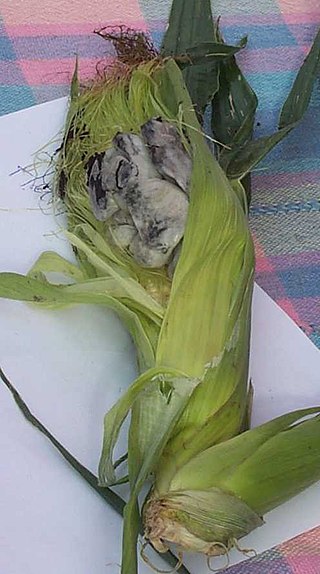
Ustilaginomycetes is the class of true smut fungi. They are plant parasites with about 1400 recognised species in 70 genera. They have a simple septum with a septal pore cap, this is different from Agaricomycotina which has a dolipore septum with parenthoesome. The group is monophyletic.

The Ustilaginales are an order of fungi within the class Ustilaginomycetes. The order contained 8 families, 49 genera, and 851 species in 2008.

The Ustilaginomycotina is a subdivision within the division Basidiomycota of the kingdom Fungi. It consists of the classes Ustilaginomycetes and Exobasidiomycetes, and in 2014 the subdivision was reclassified and the two additional classes Malasseziomycetes and Monilielliomycetes added. The name was first published by Doweld in 2001; Bauer and colleagues later published it in 2006 as an isonym. Ustilagomycotina and Agaricomycotina are considered to be sister groups, and they are in turn sister groups to the subdivision Pucciniomycotina.
Thecaphora is a genus of basidiomycote fungus which contains several species of plant pathogens. The widespread genus contained about 57 species in 2008. and held 61 species in 2020.
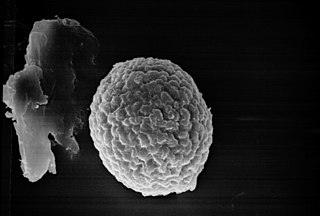
The Tilletiales are an order of smut fungi in the class Exobasidiomycetes. It is a monotypic order, consisting of a single family, the Tilletiaceae, which contains seven genera. The roughly 150 species in the Tilletiales all infect hosts of the grass family, except for species of Erratomyces, which occur on legumes.
Conidiosporomyces is a genus of fungi in the smut family Tilletiaceae. The genus was described in 1992 to accommodate the species formerly known as Tilletia ayresii, first described by British naturalist Miles Joseph Berkeley in 1899. The species C. verruculosus was described in 1993. Species in the genus are plant pathogens that affect various grasses.
Ingoldiomyces is a genus of fungi in the Tilletiaceae family. This is a monotypic genus, containing the single species Ingoldiomyces hyalosporus.
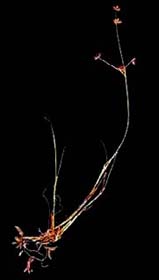
Entorrhizomycetes is the sole class in the phylum Entorrhizomycota within the Fungi subkingdom Dikarya along with Basidiomycota and Ascomycota. It contains three genera and is a small group of teliosporic root parasites that form galls on plants in the Juncaceae (rush) and Cyperaceae (sedge) families. Prior to 2015 this phylum was placed under the subdivision Ustilaginomycotina. A 2015 study did a "comprehensive five-gene analyses" of Entorrhiza and concluded that the former class Entorrhizomycetes is possibly either a close sister group to the rest of Dikarya or Basidiomycota.
The Microbotryales are an order of fungi in the Microbotryomycetes class of the Basidiomycota. The order contains 2 families, 9 genera, and 114 species. The order was circumscribed in 1997.
The Exoteliospora is a monotypic, genus of smut fungi in the family Melanotaeniaceae which contains the single species Exoteliospora osmundae.
The Melanotaenium is a genus of smut fungi in the family Melanotaeniaceae.
Yelsemia is a genus of smut fungi in the family Melanotaeniaceae, containing four species.
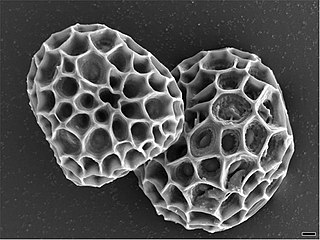
Bauerago is a genus of fungi found in the family Microbotryaceae. It contained 9 species before being reduced to 5 species.
Robert Bauer was a German mycologist, specialising in rust (Uredinales) and smut (Ustilaginomycetes) fungi.
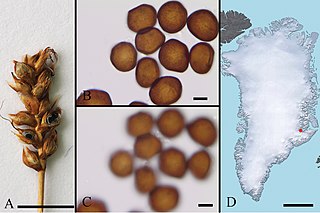
Anthracoidea is a genus of smut fungi belonging to the family Anthracoideaceae.
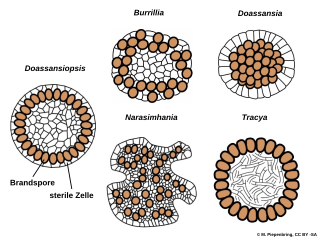
Doassansiopsis is a genus of smut fungi belonging to the monotypic family DoassansiopsidaceaeBegerow, R.Bauer & Oberw., 1998, within the class Ustilaginomycetes and order Urocystidales.

The Urocystidales are an order of fungi within the class Ustilaginomycetes. The order contains 6 families and about 400 genera. They are a sister order to Ustilaginales.

The Doassansiaceae are a family of fungi in the division Basidiomycota and order of Doassansiales. The family contains 11 genera and about 58 species. They have a widespread distribution. Doassansiaceae is also known and classified as a smut fungi.
The Melaniellaceae are a family of fungi in the division Basidiomycota and order of Doassansiales. The family contains 1 genera and 2 species. They have a distribution in south and south-east Asia.

The Rhamphosporaceae is a family of fungi in the division Basidiomycota and order of Doassansiales. The monotypic family only contains 1 genus; RhamphosporaD.D.Cunn. and just 1 species, Rhamphospora nymphaeaeD.D.Cunn. It is found on the leaves of waterlilies causing spots.
References
- 1 2 (Zambett. & Foko) Vánky & R. Bauer, in Vánky, Mycoscience 37(2): 183 (1996)
- ↑ Kirk MP, Cannon PF, Minter DW, Stalpers JA (2008). Dictionary of the Fungi. 10th edition. Wallingford: CABI. p. 275. ISBN 0-85199-826-7.
- ↑ "Species Fungorum - Names Record". www.speciesfungorum.org. Retrieved 25 September 2023.